
Bienvenue sur AOC Cornas
en visitant ce site, je certifie que j'ai l'âge légal pour la consommation d'alcool dans mon pays de résidence.
To view the AOC Cornas website you must be of legal drinking age within your country of residence.
If no such laws exist in your country you have to be over 18 to visit our website.
ENTRER / ENTER
L'ABUS D'ALCOOL EST DANGEREUX POUR LA SANTE.
À CONSOMMER AVEC MODERATION
History !
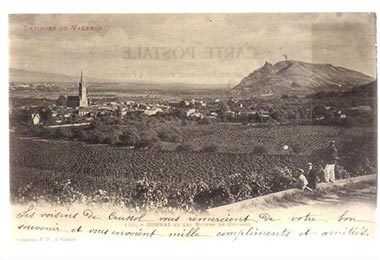
Cornas - Les ruines de Crussol
Introduction
Saved by its age-old quality
In 1874, Amédée Pichot speaks of Cornas wines in these terms :
This contradictory renown of a wine of very fine quality but which remains in the shadow of certain other winegrowing areas will continue through the ordeal of phylloxera. In 1833, the Cornas winegrowing area seems in even better health than its neighbouring vineyards on the right bank of the Rhone, as an account published in the “ La Vigne américaine et la culture de la vigne en Europe” indicates: : « Whereas on the right bank of the Rhone we perceive the slopes of Serves, of Tain de l’Ermitage stripped bare of vines, except for a few plots in the lower areas of lesser quality, the Saint-Joseph area on the right bank of the Rhone remains healthy still, over a great expanse. The same goes for the rich winegrowing area of Cornas ». Fortunately, the Cornas winegrowing area owes its revival to its very long existence. The large majority of vineyards in the Ardèche region destroyed during the phylloxera crisis were not systematically replanted afterwards, undoubtedly due to a lack of financial means. The only areas re-established with great fervour, in accordance with the traditional model, were those whose terroirs possessed age-old renown, such as those of Cornas and its direct neighbour, Saint-Péray. The Cornas winegrowing area seems saved, and now all that remains to do is to defend, protect and promote it. From the beginning of the 20th century, a Society of Winegrowers and Wine Merchants of the Côtes-du-Rhône came into existence with the principal aim of « promoting and communicating as widely as possible the renown of the excellent wines and growths of the Côtes-du-Rhône ». Ce fut le combat d’un personnage loué par ses pairs : Marius Cherpe. En témoigne ce texte nécrologique paru lors de sa disparition dans le Bulletin de la Société d’Archéologie de la Drôme en 1918 : « His love for his native land gave his life productive impetus, directing him towards a goal for which he strove incomparably hard: he promoted and presented for tasting wines of the great growths of the Rhone Valley, Côte-Rôtie, Crozes, Hermitage, Mercurol, Saint-Joseph, Cornas, Saint-Péray, to mention but a few. He had set up a syndicate, of which he was the selfless president and this syndicate’s sole aim was the sale of wines produced by the owners ». It was the first foundation stone upon which the INAO (French Institute for Appellations of Origin) would be established, to protect winegrowing areas from 1936 onwards and that of Cornas from 1938.
« The landscape laughs and sings; it is joyful and lively like the wine harvested here. This wine possesses all the same qualities that established the fame of l’Ermitage; and the wines of Cornas are consumed today under the name of Saint-Joseph, without even the most skilled wine tasters being able to discover this trickery ».
This contradictory renown of a wine of very fine quality but which remains in the shadow of certain other winegrowing areas will continue through the ordeal of phylloxera. In 1833, the Cornas winegrowing area seems in even better health than its neighbouring vineyards on the right bank of the Rhone, as an account published in the “ La Vigne américaine et la culture de la vigne en Europe” indicates: : « Whereas on the right bank of the Rhone we perceive the slopes of Serves, of Tain de l’Ermitage stripped bare of vines, except for a few plots in the lower areas of lesser quality, the Saint-Joseph area on the right bank of the Rhone remains healthy still, over a great expanse. The same goes for the rich winegrowing area of Cornas ». Fortunately, the Cornas winegrowing area owes its revival to its very long existence. The large majority of vineyards in the Ardèche region destroyed during the phylloxera crisis were not systematically replanted afterwards, undoubtedly due to a lack of financial means. The only areas re-established with great fervour, in accordance with the traditional model, were those whose terroirs possessed age-old renown, such as those of Cornas and its direct neighbour, Saint-Péray. The Cornas winegrowing area seems saved, and now all that remains to do is to defend, protect and promote it. From the beginning of the 20th century, a Society of Winegrowers and Wine Merchants of the Côtes-du-Rhône came into existence with the principal aim of « promoting and communicating as widely as possible the renown of the excellent wines and growths of the Côtes-du-Rhône ». Ce fut le combat d’un personnage loué par ses pairs : Marius Cherpe. En témoigne ce texte nécrologique paru lors de sa disparition dans le Bulletin de la Société d’Archéologie de la Drôme en 1918 : « His love for his native land gave his life productive impetus, directing him towards a goal for which he strove incomparably hard: he promoted and presented for tasting wines of the great growths of the Rhone Valley, Côte-Rôtie, Crozes, Hermitage, Mercurol, Saint-Joseph, Cornas, Saint-Péray, to mention but a few. He had set up a syndicate, of which he was the selfless president and this syndicate’s sole aim was the sale of wines produced by the owners ». It was the first foundation stone upon which the INAO (French Institute for Appellations of Origin) would be established, to protect winegrowing areas from 1936 onwards and that of Cornas from 1938.
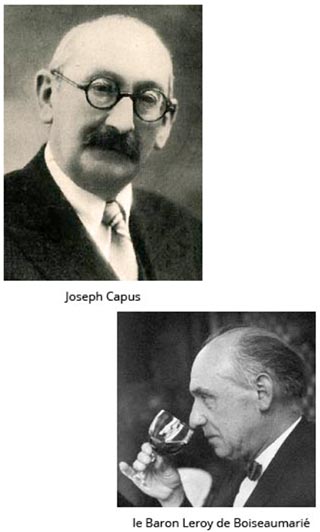
1938 - 1947
Recognition at last
Marius Cherpe had paved the way towards a new era for protecting the quality of wines.
Two years later, in 1938, Joseph Capus became the first president of the CNAO, whereas
at the same time, an AOC (Appellation of Controlled Origin) was awarded for the very
first time, not to a wine, but to a drupe fruit: the walnut of Grenoble.
Comprised initially of eight articles, it marked the start of a new adventure: one in which the great quality of wine from this area is truly appreciated at last! The article is,moreover, very clear : « The only wines which have the right to the Appellation Contrôlée Cornas are red wines which comply with the following conditions: that they have been harvested within the area of the village of Cornas, with the exception of plots situated on recent alluvium and land of the alluvial plain ».
Symbol or obvious fact, the decade that followed produced the great vintages of 1942
and 1943, excellent even with 1946 and exceptional with 1945 and 1947. This contrasted with the general context of the Second World War and German occupation. At the death of Joseph Capus in 1947, the CNAO became the INAO, whose president was Baron Leroy de Boiseaumarié. A period of chaos made way now for a brighter era of great improvements, which could not fail to be positive for the Cornas AOC.
Two years later, in 1938, Joseph Capus became the first president of the CNAO, whereas
at the same time, an AOC (Appellation of Controlled Origin) was awarded for the very
first time, not to a wine, but to a drupe fruit: the walnut of Grenoble.
In the same year, the decree of the AOC Cornas was published in the Journal Officiel.
Comprised initially of eight articles, it marked the start of a new adventure: one in which the great quality of wine from this area is truly appreciated at last! The article is,moreover, very clear : « The only wines which have the right to the Appellation Contrôlée Cornas are red wines which comply with the following conditions: that they have been harvested within the area of the village of Cornas, with the exception of plots situated on recent alluvium and land of the alluvial plain ».
Symbol or obvious fact, the decade that followed produced the great vintages of 1942
and 1943, excellent even with 1946 and exceptional with 1945 and 1947. This contrasted with the general context of the Second World War and German occupation. At the death of Joseph Capus in 1947, the CNAO became the INAO, whose president was Baron Leroy de Boiseaumarié. A period of chaos made way now for a brighter era of great improvements, which could not fail to be positive for the Cornas AOC.

Dauphiné Libéré, Lundi 3 Décembre 1956
1948 - 1957
Solidarity and promotion
After the Second World War, came years of fraternity, peace and cooperation. Nations
sign the Declaration of Human Rights in 1948 and the Treaty of Rome in 1957, which lay the foundations of the future European Economic Community. This post-war period is also an era of economic resurgence, with rebuilding, modernisation and the start of mass consumption.
Various wine cooperatives are established. In 1952, the Cornas Cooperative Cellar came into existence. Its head office is located in Rue du Ruisseau! Its objective, according to article 3 of its statutes : “make and sell wines which come exclusively from vineyards owned by cooperative members.”
In 1953, the Cave Coopérative de Vieillissement et de Champagnisation de Saint- Péray-Cornas is officially established. Its head office is located on the road that runs from
Lyon to Saint-Péray. Its objective, according to article 3 of its statutes : « the ageing, champagnization and joint sale of wines produced by members ».
In 1956, the estate owners in Cornas decide to set up a Cooperative for the Use of Agricultural Equipment (named in French the CUMA).
The quality of Cornas wines continues to ride the wave of success of the previous decade. All the conditions seem combined to make excellent wines. Seven years share good vintages, 1953 and 1956, a very good vintage, 1950, great vintages, 1949, 1952 and 1953 and the magnificent vintage of 1957.
So, now it is time to plan the AOC’s promotion. This will be the main aim of a Wine Show organised on the 1st Sunday of December in 1956 in one of Cornas’ reception rooms, an idea put forward by the recently established Syrah and Roussette Wine Fraternity.
sign the Declaration of Human Rights in 1948 and the Treaty of Rome in 1957, which lay the foundations of the future European Economic Community. This post-war period is also an era of economic resurgence, with rebuilding, modernisation and the start of mass consumption.
Locally, several projects show this period of revival. A handful of enthusiastic, committed winegrowers believe in their appellation. Georges Bessenay is one of these.
Various wine cooperatives are established. In 1952, the Cornas Cooperative Cellar came into existence. Its head office is located in Rue du Ruisseau! Its objective, according to article 3 of its statutes : “make and sell wines which come exclusively from vineyards owned by cooperative members.”
In 1953, the Cave Coopérative de Vieillissement et de Champagnisation de Saint- Péray-Cornas is officially established. Its head office is located on the road that runs from
Lyon to Saint-Péray. Its objective, according to article 3 of its statutes : « the ageing, champagnization and joint sale of wines produced by members ».
In 1956, the estate owners in Cornas decide to set up a Cooperative for the Use of Agricultural Equipment (named in French the CUMA).
The quality of Cornas wines continues to ride the wave of success of the previous decade. All the conditions seem combined to make excellent wines. Seven years share good vintages, 1953 and 1956, a very good vintage, 1950, great vintages, 1949, 1952 and 1953 and the magnificent vintage of 1957.
So, now it is time to plan the AOC’s promotion. This will be the main aim of a Wine Show organised on the 1st Sunday of December in 1956 in one of Cornas’ reception rooms, an idea put forward by the recently established Syrah and Roussette Wine Fraternity.
Georges Bessenay, born in April 1925, becomes President of the Cornas Wine Production CUMA (Cooperative for the Use of Agricultural Equipment) when it is founded in 1956. He also takes part in creating the Agricultural Cooperative of Oenology in 1958 and the Cooperative for Soil Cultivation in 1959. Georges Bessenay’s work is also found in the establishment of the Syrah and Roussette Fraternity, of which he is the founding-president. Following his demise, an extraordinary meeting is held on 19th June 1971, during which one of the members of the fraternity says: “The Syrah and Roussette Fraternity is still alive and fully active.” Successive accounts given by the Grand Master, Guy de Barjac, by the Grand Chamberlain, Pierre Giry and by the Grand Financier, Roland Came, all agree upon one idea: Georges Bessenay’s work must continue : « It must be our way of paying tribute and to continuing the memory of its dear founding-president (…) We owe him this through friendship and gratitude. Within our Fraternity, he took upon himself all his roles with such dedication. ».
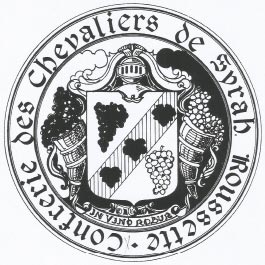
Bulletin de la Confrérie des Chevaliers de Syrah-Roussette, Année 1973
1958 - 1967
Syrah, nothing but Syrah
Two world events are of note in 1958: the Agreement of Lisbon sees the INAO’s policy expand with 27 countries fighting for the protection of Appellations; and the Treaties of Rome, signed the previous year, coming into force. As of 1962, the EEC determines the outlines of the common agricultural policy (CAP), as well as the Common Market Organisation for wine production.
In Cornas, article 2 of the decree of 5th August 1938 highlights the only grape variety permitted and authorised for its appellation: “Red wines having the right to the AOC Cornas must be made only with the Syrah variety.”
Of course, the cultivation of the Syrah variety had existed for a very long time, as we can read in a letter from 1842, sent to Mr Decazes, grand referendary of the Chamber of Peers in Paris : « Black Syrah: it is one of the finest wines of France on the hillside of L’Hermitage (Drôme) and still very good, in Cornas, in Saint-Joseph and other slopes along the edge of the Rhone, in Ardèche. Grape bunches are of average size and so are its berries; this variety ripens in mid-season and is it also known by the name Siranne ».
Its aim is to « gather for the day devoted to the wine of Cornas and on all occasions deemed useful, all its members who will combine their efforts to ensure the promotion and prosperity of wines made by these noble vines, “Syrah and Roussette”, whose value and qualities must continue to increase. Lastly, encourage winegrowers to commit themselves with determination to this approach ».
During this decade, Cornas continues its Wine Day, buoyed by good harvests and references of quality with good vintages like 1964, very good 1958, 1966 and 1967, very good 1959 and 1962 and excellent 1961. Some of them will receive awards at the General Agricultural Competition at the very first Agricultural Show organised in Paris, a project coordinated by Edgar Pisani.
In Cornas, article 2 of the decree of 5th August 1938 highlights the only grape variety permitted and authorised for its appellation: “Red wines having the right to the AOC Cornas must be made only with the Syrah variety.”
Of course, the cultivation of the Syrah variety had existed for a very long time, as we can read in a letter from 1842, sent to Mr Decazes, grand referendary of the Chamber of Peers in Paris : « Black Syrah: it is one of the finest wines of France on the hillside of L’Hermitage (Drôme) and still very good, in Cornas, in Saint-Joseph and other slopes along the edge of the Rhone, in Ardèche. Grape bunches are of average size and so are its berries; this variety ripens in mid-season and is it also known by the name Siranne ».
A sign of recognition for this variety, the Fraternity established in 1956 took the name for itself: The Fraternity of the Knights of Syrah and Roussette.
Its aim is to « gather for the day devoted to the wine of Cornas and on all occasions deemed useful, all its members who will combine their efforts to ensure the promotion and prosperity of wines made by these noble vines, “Syrah and Roussette”, whose value and qualities must continue to increase. Lastly, encourage winegrowers to commit themselves with determination to this approach ».
During this decade, Cornas continues its Wine Day, buoyed by good harvests and references of quality with good vintages like 1964, very good 1958, 1966 and 1967, very good 1959 and 1962 and excellent 1961. Some of them will receive awards at the General Agricultural Competition at the very first Agricultural Show organised in Paris, a project coordinated by Edgar Pisani.
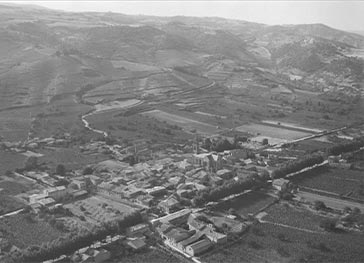
Archives départementales de l'Ardèche, fonds Cellard, 28 Fi 177
1968 - 1977
Vines or houses
In France, the post-1968 decade is a period of rapid urban development with, among other things, major projects launched by the President of the Republic, Georges Pompidou, sometimes called “France’s leading architect.” The Cornas region and its winegrowing area must also cope with certain difficulties. Jacques Eydaleine, Grand Master of the Wine Fratenity, warns local politicians and launches an appeal in his editorial of the Fraternity’s news bulletin n°3 : « But, located in a region undergoing considerable demographic development, construction is blithely invading the largely exposed winegrowing area and is increasingly leading to the reduction of the size of vineyards. Another problem too is the growing age of wine estate owners who are without children to continue working this land.” ».
Jacques Eydaleine was undoubtedly right to have been so concerned. According to an enquiry carried out in 1854, the Cornas winegrowing area covered a total of 128 hectares and by 1995 this was reduced to just 84 hectares, before rising again in 2007 to 111 hectares. The landscape of Cornas must continue to enthral, just as it captivated local poet and singer Antonin Lugnier :
« If I were an artist or a land surveyor
I would like to go, as from tomorrow,
To make a sketch of each metre of this terrain,
of the places praised by my refrain.
I would admire all the vines,
I would count each one of the stakes,
So that my verses would be worthy
Of the barrels that are filled there.
So I give my vote
to these treasures of our soil,
Ampuis, Tain, Cornas, Ermitage
Condrieu, Saint-Péray and Crussol.»
The quality of Cornas wines remains consistent and regular: 1969, 1970, 1972 and 1976 are considered great vintages; 1973 a very good vintage and 1971 a good year; Victim of its own success at different levels, the Cornas wine market must allow its organisation to progress. In 1974, the inauguration of the Community Centre is the occasion to announce that the wine market will be held from now on during the first weekend of December.
Because the challenge is indeed this: to protect the Cornas winegrowing area.
Jacques Eydaleine was undoubtedly right to have been so concerned. According to an enquiry carried out in 1854, the Cornas winegrowing area covered a total of 128 hectares and by 1995 this was reduced to just 84 hectares, before rising again in 2007 to 111 hectares. The landscape of Cornas must continue to enthral, just as it captivated local poet and singer Antonin Lugnier :
« If I were an artist or a land surveyor
I would like to go, as from tomorrow,
To make a sketch of each metre of this terrain,
of the places praised by my refrain.
I would admire all the vines,
I would count each one of the stakes,
So that my verses would be worthy
Of the barrels that are filled there.
So I give my vote
to these treasures of our soil,
Ampuis, Tain, Cornas, Ermitage
Condrieu, Saint-Péray and Crussol.»
The quality of Cornas wines remains consistent and regular: 1969, 1970, 1972 and 1976 are considered great vintages; 1973 a very good vintage and 1971 a good year; Victim of its own success at different levels, the Cornas wine market must allow its organisation to progress. In 1974, the inauguration of the Community Centre is the occasion to announce that the wine market will be held from now on during the first weekend of December.
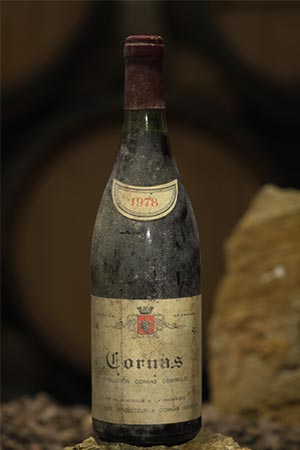
Cornas, Domaine Alain Voge, 1978
1978 - 1987
Hillsides and local customs
This decade begins with THE vintage of the Millenium...
for ten years, magnificent vintages follow one after another, with 1983, the great vintage 1986, the very good vintages 1980 and 1982 and good vintages 1979 and 1980. This collection of fine vintages is the consequence of what is mentioned in Article 6 of the initial decree of the AOC Cornas : « Red wines having the right to the “Cornas” Appellation of Controlled Origin must come from grapes harvested at a good stage of ripeness and the wine must be made in accordance with local customs ». But on this land comprised mainly of slopes, what exactly are these local customs ?
To explain to us, let’s read Olivier de Serres again, because he refers to these local customs : « There is a remedy for the lack of earth, but it is with exertion that it will be enriched (…) If the vines’ soil is full of water, this will be drained by open or closed trenches (…) Soil on the mountain or on an excessively steep slope, will be made less steep by transversal walls of dry stone, known as “bancs & colles”, which will be built in several places, closer and closer to one another.. to hold back the earth that rainfall and frequent ploughing do not pull downwards; let’s hope that the convenience of stone, being on site or nearby, will help with this work ».
Of the five types developed by the agronomist in the various winegrowing regions of France for cultivating vines on this type of soil, the wooden vine stake - or paisseau - interests us : « Be careful, however, that your new plants are always kept very upright, without being knocked over by any event, either by earth or stone falls or violent winds. It is wished to have the convenience of woods, to find a supply the small wooden stakes in sufficient number, in order to place a stake at each vine stock, as in other places it is done, such as at Viviers en Vivarets, to attach firmly to protect the vines from any harmful shaking; in this way helping the vine in its youth to progress and grow ».
Today still, a vine grower working in the Cornas area follows this same tradition. Not only does he have to grow his vines well all year round, but he must also show solid skills as a builder, following the example of his eminent forebears.
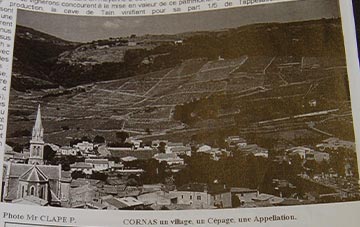
Bulletin Municipal, Cornas Horizon 2000
1988 - 1997
One for all and all for one !
« CORNAS, a village, a grape variety, an appellation »,
we can read beneath the photo that features on the first page of the local news bulletin n°2 of October 1995. Cornas boldly asserts itself and identifies with its winegrowing area, at last!
Once again, the vintages of this decade give their support to this assertion: after 1978, 1989 is considered as the Vintage of the Century; 1990 is exceptional, 1988 a very great vintage. And 1994, 1995, 1996 and 1997 are great vintages !
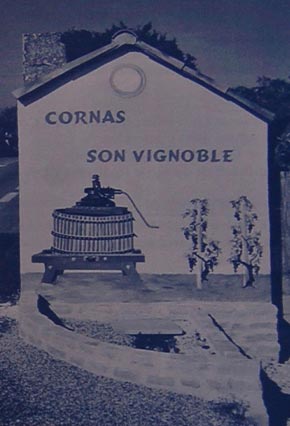
Bulletin Municipal, Cornas au pied des Coteaux, Mai 2003
1998 - 2007
The appellation’s hallmark
From now on, we hear regularly: “Cornas, a village, a grape variety, an appellation” and we could add “a hillside”. Because the charm of this small village stems particularly from this renowned hillside, as Anne-Marie Sausset writes : « Spread out at the foot of a slope entirely planted with high quality grape varieties, it produces full-bodied wine, remarkable for its aroma and elegance. The extraordinary orientation of its winegrowing area, its sub-soil, as well as the meticulous care given to vine pruning, constant health treatments and the vinification of its robust wine, whose renown is widely established, place Cornas in a privileged situation (…) Thanks to its geographical position: 45° parallel, to its total amount of sunshine hours (…), our viticultural district offers wines of top quality that compete with the most reputed names ».
Two frescos created in 2004, found at the southern and northern entries to the village remind us of its inhabitants’ pride for their village and its landscape.
As for vintages, this decade is quite extraordinary. Firstly with 1998, an exceptional vintage that echoes the success of France as World Football Champion that year. In 2000, France became the first nation to achieve the feat of being double champion - of the World and of Europe in 2000 and this vintage, just after having been produced, is hailed as being Vintage of the Century! Others such as 1999 and 2007 will be great vintages; 2003, 2004 and 2006 magnificent vintages and 2005 exceptional.
Quite evidently, the slope marks the character of Cornas. The village news bulletin is named “Cornas, at the foot of the slopes ».
Two frescos created in 2004, found at the southern and northern entries to the village remind us of its inhabitants’ pride for their village and its landscape.
As for vintages, this decade is quite extraordinary. Firstly with 1998, an exceptional vintage that echoes the success of France as World Football Champion that year. In 2000, France became the first nation to achieve the feat of being double champion - of the World and of Europe in 2000 and this vintage, just after having been produced, is hailed as being Vintage of the Century! Others such as 1999 and 2007 will be great vintages; 2003, 2004 and 2006 magnificent vintages and 2005 exceptional.
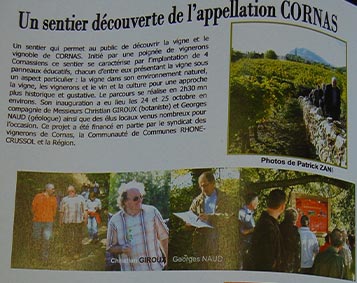
Bulletin Municipal, La Gazette de Cornas, Février 2010
2008 - 2017
Beautiful nature
This decade promises to offer a wealth of events. In 2008, a policy for merging the protection systems for AOCs is established on a European scale: the AOC becomes AOP, Appellation of Protected Origin.
Although in existence since the 19th century in other forms (particularly the well-known wine routes recommended by the Touring Club), wine tourism closely combining tourism and wine, has become well-structured since 2007, thanks especially to the Dubrule report.
In 2011, the Cornas AOC is revised and edited. The decree of 1938 is conserved for the most part. Whereas some articles are reorganised, others appear. They concern mainly new winemaking techniques (Chap. 1, art.9), temporary measures following uprooting or replanting vines (Chap. I, art. 11) and obligations for declarations (Chap. II, art. 1).
www.aoc-cornas.fr/aoc
At the same time, AOC producers continue to make fine vintages: a good 2013, very good 2008 and 2012, great vintages in 2010, 2014, 2016 and 2017, a magnificent vintage in 2009, an excellent vintage in 2011 and an exceptional vintage in 2015.
Although in existence since the 19th century in other forms (particularly the well-known wine routes recommended by the Touring Club), wine tourism closely combining tourism and wine, has become well-structured since 2007, thanks especially to the Dubrule report.
The AOC Cornas inaugurates in 2010 its “Nature Trail to discover the Cornas appellation” and is enhanced by a new certification label: “Vignobles et Découvertes.”.
In 2011, the Cornas AOC is revised and edited. The decree of 1938 is conserved for the most part. Whereas some articles are reorganised, others appear. They concern mainly new winemaking techniques (Chap. 1, art.9), temporary measures following uprooting or replanting vines (Chap. I, art. 11) and obligations for declarations (Chap. II, art. 1).
www.aoc-cornas.fr/aoc
At the same time, AOC producers continue to make fine vintages: a good 2013, very good 2008 and 2012, great vintages in 2010, 2014, 2016 and 2017, a magnificent vintage in 2009, an excellent vintage in 2011 and an exceptional vintage in 2015.
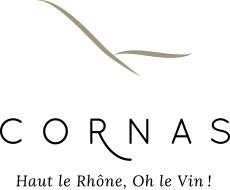
2018
The AOC is celebrating its 80th year !
The AOC is celebrating its 80th year of existence and this vintage already looks to be very promising, even a great vintage.
The elders worked so hard for this position that is so well deserved. A new generation has taken over under the watchful eye of the key figures of wine production in the village. Handing down is happening and Cornas still holds plenty of suprises…
Texte, Éric Permingeat, Historien, Conte moi un terroir
www.contemoiunterroir.fr
Sources
- Arch. Dép. Ardèche, 4 U 19
- Arch. Dép. Ardèche, 7 Mi 66
- Arch. Dép. Ardèche, PER 2052
- Arch. Dép. Ardèche, PER 2812
Bibliographie
- Olivier de Serres, Théâtre d'Agriculture et Mesnage des Champs, 1605.
- Guide pittoresque du voyageur en France, Tome 6, Paris, 1838.
- D Stramler, Guide de la Cave, Toulouse, 1866.
- La Vigne Américaine et la culture de la vigne en Europe, Mâcon, Janvier 1901.
- Bulletin de la Société d'Archéologie de la Drôme, Valence, 1918.
- Le Sommelier, Revue Mensuelle officielle et propriété exclusive de l'Union des Sommeliers de Paris, n° 128, 1934.
Dauphiné Libéré, 8 Décembre 1958
Dauphiné Libéré, 2 Décembre 1968
Recognition for the wines of Cornas continues to grow.…
The elders worked so hard for this position that is so well deserved. A new generation has taken over under the watchful eye of the key figures of wine production in the village. Handing down is happening and Cornas still holds plenty of suprises…
Texte, Éric Permingeat, Historien, Conte moi un terroir
www.contemoiunterroir.fr
Sources
- Arch. Dép. Ardèche, 4 U 19
- Arch. Dép. Ardèche, 7 Mi 66
- Arch. Dép. Ardèche, PER 2052
- Arch. Dép. Ardèche, PER 2812
Bibliographie
- Olivier de Serres, Théâtre d'Agriculture et Mesnage des Champs, 1605.
- Guide pittoresque du voyageur en France, Tome 6, Paris, 1838.
- D Stramler, Guide de la Cave, Toulouse, 1866.
- La Vigne Américaine et la culture de la vigne en Europe, Mâcon, Janvier 1901.
- Bulletin de la Société d'Archéologie de la Drôme, Valence, 1918.
- Le Sommelier, Revue Mensuelle officielle et propriété exclusive de l'Union des Sommeliers de Paris, n° 128, 1934.
Dauphiné Libéré, 8 Décembre 1958
Dauphiné Libéré, 2 Décembre 1968